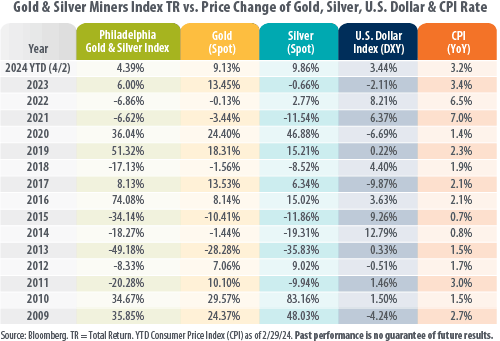by Bob Carey, Chief Market Strategist, First Trust Portfolios
View from the Observation Deck
Today's blog post illustrates the wide disparities that often exist between the annual price performance of an ounce of gold bullion, silver, and the equity returns posted by mining companies. Since precious metals tend to be priced in U.S. dollars, we also included a column that tracks the relative strength of the U.S. dollar against a basket of other major currencies.
- Precious metals have historically been considered potential inflation hedges by investors. From 1926-2023, the 12-month rate of change on the Consumer Price Index (CPI) averaged 3.0%, according to data from the Bureau of Labor Statistics. It stood at 3.2% at the end of February 2024, down from its most-recent high of 9.1% set in June 2022, but up from its most recent low of 3.0% in June 2023.
- The price of gold has been trending upward. The spot price of one ounce of gold stood at a record $2,261.00 on 4/2/24, an increase of 9.13% on a year-to-date (YTD) basis according to data from Bloomberg.
- The spot price of silver also increased over the same time frame. The spot price of one ounce of silver rose by 9.86% on a YTD basis thru 4/2/24. That said, unlike gold, the spot price of silver has not recovered to its all-time high. The price of one ounce of silver stood at $26.14 on 4/2/24, 47.14% below its all-time high of $49.45 set on 1/18/80.
- In 2023, the spot price of the U.S. dollar index peaked at $107.00 on 10/3/23 before falling to $100.99 on 12/27/23. Since then, the index increased by 3.79% to $104.82 as of 4/2/23.
- From 2009 through 2023, the Philadelphia Stock Exchange Gold & Silver Index posted a positive total return in seven of the 15 calendar years. Five of them occurred from 2016 through 2023. It is in positive territory YTD.
Takeaway: In some ways the data presented today defied our expectations. If the CPI is down 5.9 percentage points from its most-recent high, then why is it that gold is setting record highs, silver is rebounding, and the U.S. dollar is closing in on its 2023 calendar year high? From our perspective, there are several catalysts at play here. First, many investors view the U.S. dollar, gold, silver, and other precious metals as safe havens during times of turmoil. The wars between Russia/Ukraine and Hamas/Israel, as well as terrorist attacks in the Red Sea pose geopolitical risks that may be leading investors to seek refuge in these assets. Additionally, despite recent disinflation, the CPI remains well-above the Federal Reserve’s (“Fed”) target rate of 2.0%, even increasing from 3.1% in January 2024 to 3.2% in February. Other inflation metrics reveal a similar trend. The Fed’s “Core” (excludes food and energy) and “Supercore” (services only (no goods), excluding food, energy, and housing) inflation metrics rose by 2.8% and 3.3% on a y-o-y basis in February 2024, according to Brian Wesbury, Chief Economist at First Trust Portfolios L.P. Should geopolitical risk and inflation remain elevated or worsen, we expect higher valuations will occur within these safe haven assets.
The chart and performance data referenced are for illustrative purposes only and not indicative of any actual investment. The index performance data excludes the effects of taxes and brokerage commissions or other expenses incurred when investing. Investors cannot invest directly in an index. There can be no assurance that any of the projections cited will occur. The Philadelphia Stock Exchange Gold & Silver Index is a capitalization-weighted index comprised of the leading companies involved in the mining of gold and silver. The U.S. Dollar Index (DXY) indicates the general international value of the dollar relative to a basket of major world currencies. The Consumer Price Index (CPI) is a measure of the average change over time in the prices paid by urban consumers for a market basket of consumer goods and services.
To Download a PDF of this post, please click here.
Copyright © First Trust Portfolios

















